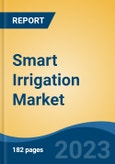Free Webex Call
The Smart Irrigation Market was valued at USD 1.73 Billion in 2024, and is expected to reach USD 3.84 Billion by 2030, rising at a CAGR of 14.21%. The Global Smart Irrigation Market has been witnessing significant growth driven by the increasing adoption of advanced technologies in agriculture and a growing need for efficient water management. Smart irrigation systems utilize sensors, weather data, and real-time monitoring to optimize water usage in agriculture, landscaping, and other applications. Speak directly to the analyst to clarify any post sales queries you may have.
10% Free customizationThis report comes with 10% free customization, enabling you to add data that meets your specific business needs.
According to the India Brand Equity Foundation, the agricultural sector is the largest consumer of freshwater in the country, using up to 78 percent of the total water supply. Furthermore, the OECD's environmental forecast for 2050 predicts that India will face significant water scarcity by that year.
Key Market Drivers
Water Scarcity Concerns
Water scarcity is a mounting global challenge, posing a significant threat to agriculture, the backbone of food production. As the world grapples with the impact of climate change and growing water demands, innovative solutions are imperative. The Global Smart Irrigation Market stands at the forefront of addressing water scarcity concerns by revolutionizing traditional irrigation practices. Water scarcity necessitates a more judicious use of available water resources. Smart irrigation systems are designed to optimize water utilization by leveraging technology to precisely monitor and control the irrigation process. Through real-time data from sensors measuring soil moisture levels, weather conditions, and crop requirements, these systems ensure that water is delivered only when and where it is needed, minimizing wastage.Climate change has brought about unpredictable weather patterns, including irregular rainfall and prolonged droughts. Smart irrigation systems, equipped with adaptive technologies, can swiftly respond to changing environmental conditions. By adjusting irrigation schedules based on up-to-the-minute data, these systems help farmers adapt to climate variability, ensuring that crops receive adequate water even in the face of erratic weather patterns. Traditional irrigation methods often result in excessive water use, leading to the depletion of vital water sources. Smart irrigation technologies contribute to the preservation of water resources by promoting precision agriculture. By tailoring irrigation practices to specific crop needs and soil conditions, these systems reduce water consumption, mitigate the risk of over-irrigation, and extend the life of available water reservoirs.
Key Market Challenges
High Initial Costs
One of the primary challenges confronting the smart irrigation market is the high initial investment required for the implementation of these advanced technologies. The cost of purchasing and installing sensors, IoT devices, and other components can be a significant barrier for farmers, especially those operating on smaller scales. The challenge lies in convincing farmers of the long-term cost benefits despite the substantial upfront expenses.Key Market Trends
Integration of Artificial Intelligence (AI)
As the capabilities of artificial intelligence continue to expand, its integration into smart irrigation systems is becoming a key trend. AI algorithms can analyze vast amounts of data collected from sensors and satellites, enabling more accurate predictions of weather patterns, crop water needs, and irrigation scheduling. This advanced level of automation and decision-making is poised to enhance the overall efficiency of smart irrigation.Key Market Players
- Rain Bird Corp
- Toro Co/The
- Hunter Industries Inc
- ET Water Systems Inc
- HydroPoint Data Systems Inc
- Rachio Inc
- Stevens Water Monitoring Systems Inc
- Orbit Irrigation Products LLC
- CALSENSE
- WEATHERMATIC
Report Scope:
In this report, the Global Smart Irrigation Market has been segmented into the following categories, in addition to the industry trends which have also been detailed below:Smart Irrigation Market, By Type:
- Climate Based
- Sensor Based
Smart Irrigation Market, By Component:
- Controllers
- Sensors
- Meters
- Others
Smart Irrigation Market, By End Use:
- Agriculture
- Golf Course
- Residential
- Others
Smart Irrigation Market, By Region:
- North America
- United States
- Canada
- Mexico
- Europe
- Germany
- United Kingdom
- France
- Italy
- Spain
- Asia-Pacific
- China
- Japan
- India
- Australia
- South Korea
- South America
- Brazil
- Argentina
- Colombia
- Middle East & Africa
- South Africa
- Saudi Arabia
- UAE
- Kuwait
Competitive Landscape
Company Profiles: Detailed analysis of the major companies present in the Global Smart Irrigation Market.Available Customizations:
With the given market data, the publisher offers customizations according to a company's specific needs. The following customization options are available for the report.Company Information
- Detailed analysis and profiling of additional market players (up to five).
This product will be delivered within 1-3 business days.
Table of Contents
1. Product Overview
2. Research Methodology
3. Executive Summary
5. Global Smart Irrigation Market Outlook
6. North America Smart Irrigation Market Outlook
7. Europe Smart Irrigation Market Outlook
8. Asia-Pacific Smart Irrigation Market Outlook
9. South America Smart Irrigation Market Outlook
10. Middle East and Africa Smart Irrigation Market Outlook
11. Market Dynamics
12. Market Trends & Developments
13. Porter’s Five Forces Analysis
14. Competitive Landscape
Companies Mentioned
- Rain Bird Corp
- Toro Co/The
- Hunter Industries Inc
- ET Water Systems Inc
- HydroPoint Data Systems Inc
- Rachio Inc
- Stevens Water Monitoring Systems Inc
- Orbit Irrigation Products LLC
- CALSENSE
- WEATHERMATIC
Table Information
| Report Attribute | Details |
|---|---|
| No. of Pages | 180 |
| Published | March 2025 |
| Forecast Period | 2024 - 2030 |
| Estimated Market Value ( USD | $ 1.73 Billion |
| Forecasted Market Value ( USD | $ 3.84 Billion |
| Compound Annual Growth Rate | 14.2% |
| Regions Covered | Global |
| No. of Companies Mentioned | 10 |









